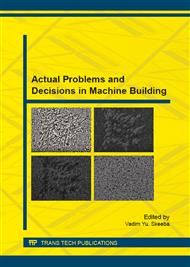p.163
p.170
p.177
p.182
p.187
p.194
p.199
p.205
p.211
Influence of Thermal Cyclic Deformation and Hardening Heat Treatment on the Structure and Properties of Steel 10
Abstract:
The results of the influence of preliminary thermal cyclic deformation and subsequent hardening heat treatment on the microstructure and mechanical properties of hot-rolled sheet steel 10 are presented. It is shown that the use of preliminary thermal cyclic deformation of the steel 10 stock material results in a fine-grained structure of a hot-rolled sheet (3 mm thick) produced by an industrial technology. Deformation occurred at a temperature above AC3 (1250 °C), with cooling to 200-300 °C during 10 cycles and the deformation ratio per cycle being 6-8 %. Such a treatment before sheet hot-rolling allows increasing the strength characteristics (tensile strength, yield strength) by almost 30 %. It has been established that the use of subsequent heat treatment (quenching, 900 °C, water and tempering 1 h, 600 °C) leads to a further increase in strength characteristics by 15-20% while maintaining a sufficient level of ductility of sheet steel.
Info:
Periodical:
Pages:
187-193
Citation:
Online since:
August 2015
Authors:
Price:
Сopyright:
© 2015 Trans Tech Publications Ltd. All Rights Reserved
Share:
Citation:


